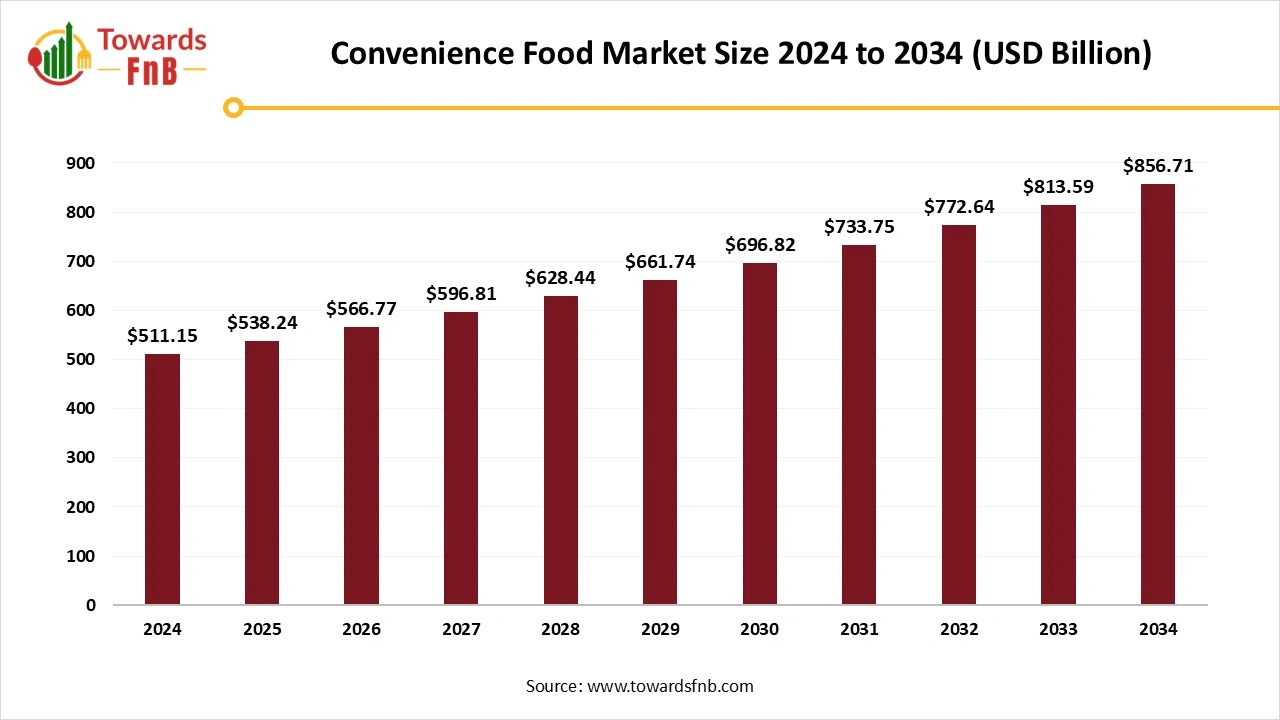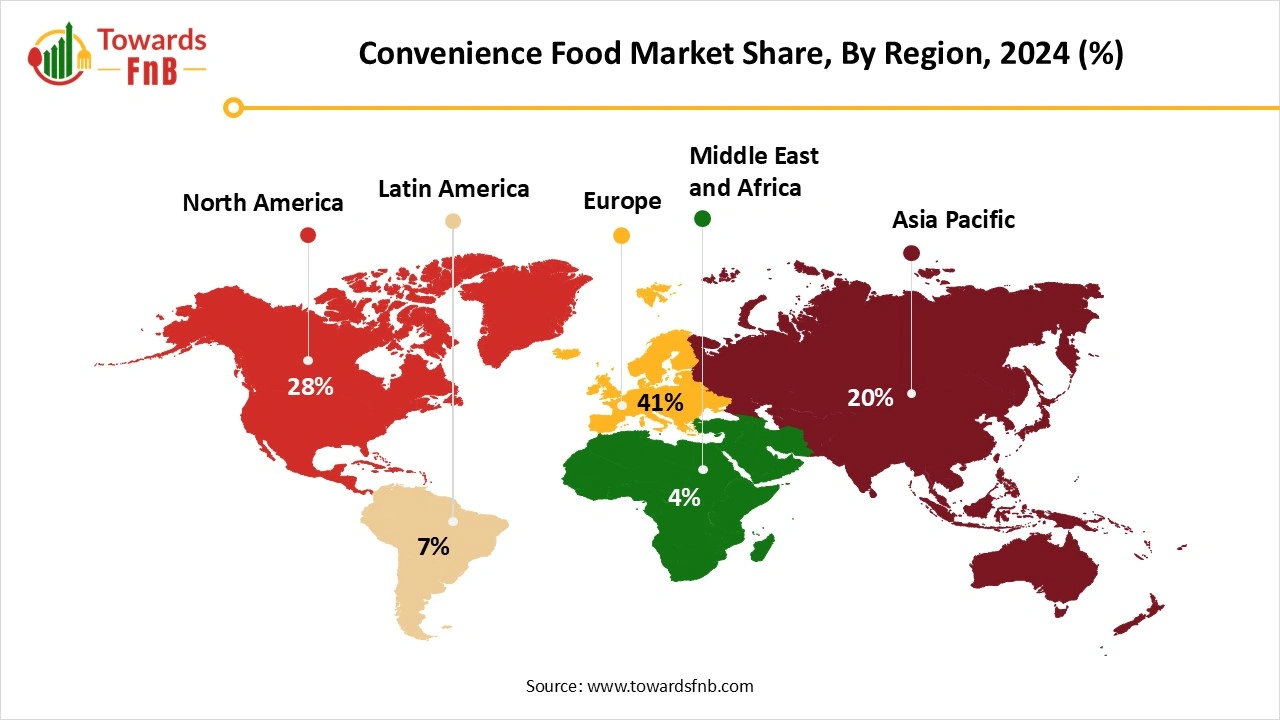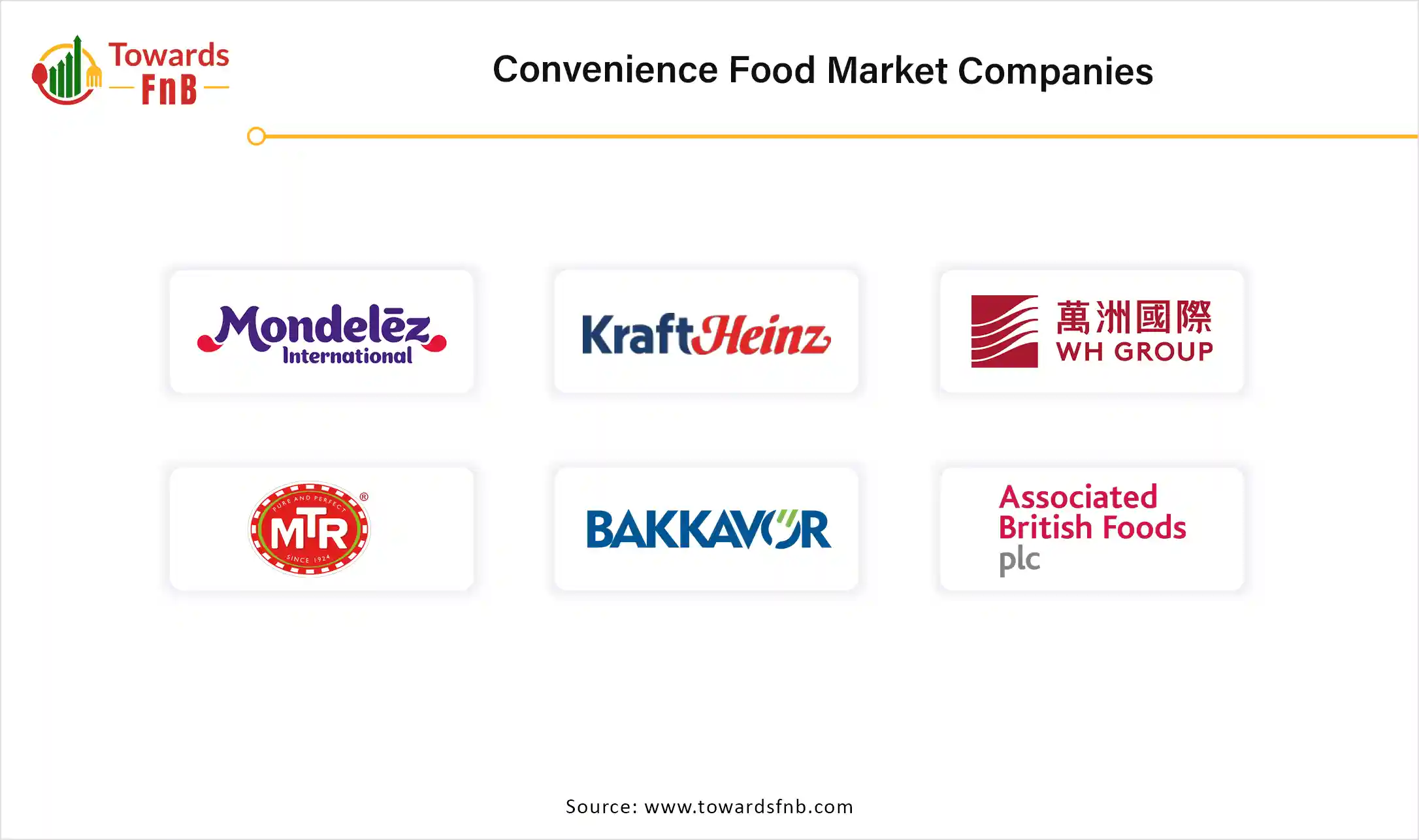December 2025
The global convenience food market size stood at USD 511.15 billion in 2024 and is forecasted to expand from USD 538.24 billion in 2025 to approximately USD 856.71 billion by 2034, at a CAGR of 5.3% during the forecast period from 2025 to 2034. The market is undergoing a profound change owing to the changing consumer’s lifestyle, priorities, increasing disposable income and rise of e-commerce platform to supply doorstep food delivery.

| Study Coverage | Details |
| Growth Rate from 2025 to 2034 | CAGR of 5.3% |
| Market Size in 2025 | USD 538.24 Billion |
| Market Size in 2026 | USD 566.77 Billion |
| Market Size by 2034 | USD 856.71 Billion |
| Largest Market | Europe |
| Base Year | 2024 |
| Forecast Period | 2025 to 2034 |
| Regions Covered | North America, Europe, Asia-Pacific, Latin America, and Middle East & Africa |
The convenience market is propelling due to various reasons including growth rate of urbanization is significant which led to a busy lifestyle, changing people’s food preferences and needs and awareness about consumable ready-to-eat food products to save time. Another key driver is increasing disposable income in the leading/emerging nations where many family members are employees and looking for easy food options on a daily basis along with health as a preference.
By acknowledging this need and increasing trends for convenient foods, many marketers from food and beverage sector have been launching innovative and ready-to-cook food products with eco-friendly preservative practices that ensures the food is safe, fresh and nutrient dense at the same time. Additionally, technological advances in food packaging ensure food’s freshness and help maintain its quality. E-commerce platforms have seemed to be activated more in recent years that provide doorstep delivery and making it easier to grab when it's needed. These platforms also showcase a list of ingredients and other details to examine food’s quality and manufacturing/expiry date. This transparency is helping to build trust among consumers looking for foods with nutrient rich elements on an online platform, further expanding the area of convenience food market.
The market holds the potential to transform its working pattern when integrated with cutting edge technology like Artificial intelligence. AI supports huge data analysis with its precise techniques and algorithms which facilitates accurate prediction for price forecasting and future demands for specific food products based on historical data of companies feed to the AI algorithms which helps foods and beverages companies to manage their production and inventories. By analyzing data about foods demand with consumers behavior companies can capitalize on price fluctuations and specific food demand.
In addition to this, real-time data analysis provides predictive results for markets situation that facilitates to recognized potential hurdles and needed adjustment in terms of foods sourcing, operations and distribution strategies which further strengthens the supply chain of convenience food market. A major benefit that companies will notice is they do not need to overstock and store foods packets which increases their efficiency and reliability about foods freshness and compliance with quality standards along with timely delivery to the consumers as per requirements., helps to reduce foods wastage as well.
One of the notable restraining factors for the convenience food market is lack of proper method to store packaged foods, processing and accurate packaging even in some of the areas which raises a question for foods quality and scale of nutrients they claim to have in it, creates a barrier to purchase chilled/ frozen convenience foods by many individuals. Also, the increasing number of stringent regulations about food safety standards are creating confusion among marketers and making it difficult to deal with such regulations in some cases.
People are also expressing concerns about frozen foods and preservatives use in it and its side effect on human gut health and creating an orthodox view about such foods in the modern era. Also, due to social media such news are spreading rapidly irrespective of their reliability may downgrade reputation of some of the companies is again a major hindrance for the market’s expansion.
Why is the Europe Dominated the Global Convenience Food Market in 2024?
The Europe region dominated the convenience food market in 2024 on a global scale due to a strong bias of European individuals about sustainability and health-consciousness for food habits. Evolving needs for daily food products and advancement in food packaging methods is again creating a strong foundation for the market to proliferate in Europe. The urban population in Europe is looking for ready-to-prepare food products to efficiently manage their time due to busy working schedules and different shifts in jobs while managing health food habits on a regular basis.
On the other verge, sustainability and eco-friendly branding that complies with stringent safety foods regulations are key driver factors for the Europe region. The government is also facilitating this angle by initiating regulations like the European Green Deal which further encourage marketers to adopt eco-friendly practices across the food sector. Retailers are also providing plant-based products on e-commerce platforms with one click option and convenience of doorstep delivery is expanding the market on a large scale.

The Asia Pacific Region is Expected to Grow at the Fastest CAGR Over the Foreseeable Period.
The convenience food market is proliferating in the Asia pacific due to increasing rate of urbanization, as leading countries like India, China, Japan are economically emerging and expanding with significant rate over the past years. Such changes in the lifestyle led to maximum time spent by people is in the offices, businesses and other workings which create lack of time to prepare meals at home, especially in metropolitan areas is escalating the demand for fresh, ready-to-cook and ready-to-eat frozen convenience foods, snacks, beverages. As these foods require minimum time to prepare, many people found it convenient, and less hustling is a major factor driving market growth.
Increasing disposable income again led to the increasing demand for international, premium food products which creates opportunity for both international and regional food suppliers and dealers. Companies are recognizing the consumers' shift towards health yet quick to prepare food alternatives and launching new food products with regulatory compliance of food safety driving the market further.
The North America Region is Expanding Significantly in the Global Market.
The market is driven by highly established infrastructure for food and beverage sector that offers instant meals, ready-to-cook foods, sustainable packaged foods, variety of fast foods as per customization, positively influencing the North America Convenience food market. A wide range of food options are made available by leading marketers set in the well-established countries like United states and Canada which includes plant-based, vegan and organic food products. Additionally, government has set strict regulations for food labelling and data presentation on foods outer container with nutritional information is gaining consumers traction and create sense of reliability on a food brands which are following these regulations.
Why is the Frozen Food Segment Dominating the Convenience Food Market?
The frozen food type segment consumed the largest market share in 2024, driven by its versatility in offering frozen products such as frozen fruits, vegetables, frozen fast foods like pizza and burger base, sauces, frozen meats, and frozen desserts. Frozen food are the most reliable food product consumed by many individuals due to its characteristics of being fresh with similar nutritional value same as freshly cooked meals. There is scientific proof about frozen products, which states that at a lower temperature, environmental interaction between foods and surrounding is minimal and halt the process of disintegration of nutritional elements in the foods making them convenient choice in a fast-paced world.
The Ready-to-Eat Foods Segment is Expected to Grow at a Significant CAGR Over the Foreseeable Period.
The growth is driven by the convenience offered by these types of food products which saves time, which is crucial for nearly everyone due to urban lifestyle. It is the core of the convenience food market. These foods come with sustainable packaging with labels that follow food safety guidelines and are majorly purchased by students residing outside at hostels, busy working professionals, and travelers looking for immediate food consumption.
Why Did Meat and Poultry Product Segment Dominate the Convenience Food Market?
The meat and poultry product segment dominated the convenience food market in 2024. The growth of this segment is attributed to the consumers preferences about eating pattern and to gain maximum proteins from meat and poultry foods products as they are the rich source of proteins and other essential elements to keep the human system energize. These food products have many options like frozen chicken, non-veg burgers and pizzas, chicken nuggets, ready-to-eat non-vegetarian meals and others that can be incorporated as a main meal or breakfast option due to their rich aroma, savory tastes and protein content.
The Cereal-Based Foods Type Segment is Expected to Grow at the Fastest CAGR During the Foreseeable Period.
It comprises breakfast cereals, granola bars, cereal snacks, quick bites made of cereal based foods, oatmeal, and others. The segment's growth is related to the demand for nutritious breakfast options with easy cooking methods with versatility and taste. Moreover, marketers are introducing various options for cereal based foods like whole-grain, high fiber, and low sugar foods which are gaining traction from health-conscious consumers.
How do Supermarkets and Hypermarkets Dominate the Convenience Food Market?
Supermarkets and hypermarkets dominated the global market in 2024 as popular distribution channels. The convenience food market is largely occupied by these outlets due to their vast product offerings with multiple brands including foods, grains and other daily required groceries. Their spacious layouts and consumer friendly treatment making them popular among individuals. The outlets are nearly everywhere in the urban cities offering a range of foods products like ready-to-cook veg and non-veg food packages, ready-to eat meals, products, frozen foods, various beverages with multiple options and brands at the same location, which is pleasing experience for people opting outside for groceries shopping.
Convenience Stores Segment is Expected to Grow at the Fastest CAGR During the Upcoming Period From 2025 to 2034.
The segment is propelling due to their strategic planning and location to offer quick and easy access for various foods products. These outlets play crucial role in urban areas and majorly placed at overly crowded location, with small area, near gas stations, bus/railway stations with intension to offer quick and on-the-go foods products for consumers seeking foods products as per their requirements.
Nestle
HyFun Foods

By Type
By Product
By Distribution channel
By Region
December 2025
December 2025
December 2025
December 2025